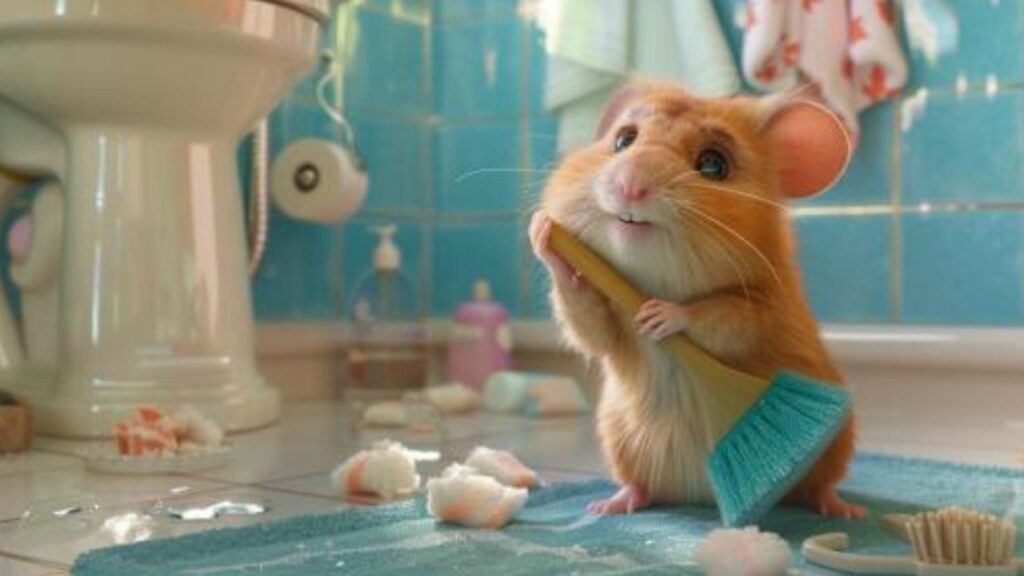Hello, fellow hamster enthusiasts and caretakers! I’m Dr. Vivian Whiskerson, your go-to expert on all things hamster care. Today, we’re diving into a topic that’s crucial for the health and happiness of our furry friends but often overlooked: the importance of sanitizing hamster accessories. Keeping your hamster’s environment clean is not just about removing visible dirt; it’s about ensuring their home is safe from harmful bacteria and viruses that can cause illness. In this guide, we’ll explore the ins and outs of keeping your hamster’s gear squeaky clean.
Importance of Cleanliness in Hamster Care
Cleanliness is paramount in hamster care for several reasons. First and foremost, a clean habitat prevents the spread of diseases. Hamsters, like any other pets, are susceptible to various bacterial and viral infections, many of which thrive in unclean environments. Secondly, a clean cage and accessories contribute to your hamster’s overall well-being, reducing stress and promoting happiness. Lastly, maintaining cleanliness helps control odors, making your living environment more pleasant for both you and your hamster.
Overview of Sanitizing Accessories
Sanitizing hamster accessories involves more than just a quick rinse under water. It requires a thorough cleaning process that eliminates harmful pathogens without exposing your hamster to dangerous chemicals. This process varies depending on the type of accessory, but generally includes washing, disinfecting, and drying. We’ll discuss the best practices for different materials and types of accessories, ensuring you have the knowledge to tackle everything from water bottles to exercise wheels.
What You’ll Learn from This Guide
By the end of this guide, you’ll be equipped with comprehensive strategies for sanitizing various hamster accessories effectively and safely. We’ll cover:
- The best cleaning solutions and disinfectants to use that are safe for your hamster.
- Step-by-step instructions for cleaning and disinfecting common accessories.
- Tips for maintaining a regular cleaning schedule to keep your hamster’s environment in top shape.
Armed with this knowledge, you’ll ensure your hamster’s home is not just clean, but healthily habitable. So, let’s roll up our sleeves and get started on our journey to a squeaky-clean hamster habitat!
Choosing the Right Cleaning Agents

When it comes to maintaining a clean and safe environment for our furry friends, selecting the appropriate cleaning agents is crucial. The wide array of options available can be overwhelming, but understanding the difference between natural and chemical cleaners, as well as recognizing our hamster’s unique needs, can guide us in making the best choices. Let’s delve into the specifics of choosing the right cleaning solutions for sanitizing hamster accessories.
Natural vs. Chemical Cleaners
The debate between using natural and chemical cleaners is a significant one in the world of pet care. Natural cleaners often consist of ingredients that are less harsh and more environmentally friendly, while chemical cleaners are known for their potent disinfecting power. The key is to find a balance between efficacy and safety, ensuring that our cleaning practices do not harm our hamsters.
Benefits of Natural Cleaners
Natural cleaners, such as vinegar or baking soda solutions, offer several benefits. They are typically non-toxic, making them safer for use around pets. Additionally, they are environmentally friendly and often less expensive than their chemical counterparts. These cleaners can be effective for daily cleaning tasks and for pet owners who prefer to avoid harsh chemicals.
When to Use Chemical Cleaners Safely
Chemical cleaners, on the other hand, are indispensable when dealing with more serious cleaning challenges, such as outbreaks of disease or to thoroughly disinfect an accessory bought second-hand. When using chemical cleaners, it’s essential to rinse the cleaned items thoroughly and allow them to air dry completely before reintroducing them to your hamster’s cage. Always follow the manufacturer’s instructions and use gloves and masks if recommended.
Recommended Products
Several pet-safe disinfectants on the market are specifically designed for cleaning animal cages and accessories. Products containing accelerated hydrogen peroxide are highly effective and safer than traditional bleach solutions. Always look for labels that indicate the cleaner is safe for use around small animals.
DIY Cleaning Solutions
For those who prefer a more hands-on approach or are looking for cost-effective methods, DIY cleaning solutions can be a great alternative.
Recipes for Safe, Homemade Cleaners
A simple and effective DIY cleaner can be made by mixing equal parts of water and white vinegar. This solution can clean and deodorize hamster cages and accessories without the harshness of chemicals. For tougher stains, adding a small amount of baking soda to the mix can provide an extra cleaning boost.
How to Test DIY Cleaners for Safety
Before using a new DIY cleaner on your hamster’s accessories, test it on a small, inconspicuous area first. Check for any adverse reactions, such as color changes or material degradation. Additionally, observe your hamster’s reaction to the cleaned items to ensure they are not stressed or allergic to the scent.
Storage and Shelf Life of Homemade Solutions
Homemade cleaning solutions, especially those made with natural ingredients, have a shorter shelf life than commercial products. Store them in airtight containers, label them with the date of creation, and typically use within a week or two. Keep them out of direct sunlight and in a cool, dry place.
Understanding Your Hamster’s Needs
Our hamsters’ health and comfort should always be at the forefront of our cleaning practices. Recognizing signs of stress and adjusting our routines accordingly can help maintain a harmonious habitat.
Identifying Signs of Stress from Strong Scents
Hamsters have a keen sense of smell, and strong scents can be overwhelming or stressful for them. If you notice your hamster becoming more reclusive, showing signs of irritation, or changing their eating habits after cleaning, they might be reacting to the scent of the cleaner used.
Adjusting Cleaning Routines to Your Hamster’s Schedule
To minimize stress, try to clean your hamster’s cage and accessories when they are most likely to be asleep or less active. Gradually introducing cleaned items back into their environment can also help them adjust without anxiety.
Allergies and Sensitivities to Consider
Just like humans, hamsters can have allergies or sensitivities to certain substances. Pay close attention to your hamster’s behavior and physical health after introducing new cleaners or changing your cleaning routine, and adjust accordingly to ensure their well-being.
In summary, choosing the right cleaning agents for sanitizing hamster accessories involves a balance between efficacy and safety. By considering the benefits of natural versus chemical cleaners, exploring DIY solutions, and prioritizing our hamster’s needs and comfort, we can create a clean, healthy, and stress-free environment for our beloved pets.
Step-by-Step Cleaning Guide for Accessories

Keeping your hamster’s accessories clean is pivotal to ensuring their home is not only comfortable but also safe from harmful microbes. An effective cleaning routine consists of daily spot cleaning, weekly deep cleans, and adjustments for seasonal changes. Let’s delve into a detailed step-by-step guide to maintaining a pristine environment for your furry friend.
Daily Cleaning Routines
Spot Cleaning Techniques
Daily maintenance is essential to prevent the buildup of waste and food remnants. Begin by removing soiled bedding, uneaten food, and droppings using a small scoop or gloves. This daily habit prevents harmful bacteria from proliferating and keeps the cage smelling fresh.
Quick Disinfection Tips
For areas that seem a bit dirtier or have come into contact with wet waste, a quick disinfection is necessary. Use a pet-safe disinfectant on a cloth or sponge to wipe down these spots. Ensure the product you use is safe for hamsters by checking the label or consulting recommendations from reliable sources.
Organizing Your Hamster’s Space
After cleaning, take a moment to reorganize your hamster’s living area. This not only keeps the space tidy but also stimulates your hamster by offering a slightly changed environment. However, maintain the general layout to avoid stressing your pet with drastic changes.
Weekly Deep Cleaning
Preparing Your Hamster’s Temporary Home
Before starting the deep cleaning process, ensure your hamster has a safe and comfortable temporary home. This can be a travel cage or a secure playpen with bedding, food, and water. The goal is to keep them stress-free while you clean.
Detailed Cleaning Steps for Various Accessories
Disassemble toys, wheels, and other accessories for thorough cleaning. Soak non-wooden items in a mixture of warm water and a pet-safe disinfectant or cleaner. Scrub each piece to remove dirt and residues, then rinse thoroughly with clean water to ensure no cleaning agent remains.
Drying and Reassembling Tips
After cleaning, dry each accessory completely before putting them back in the cage. Moisture can promote mold growth, which is harmful to your hamster. Reassemble the cage meticulously, ensuring everything is secure to prevent accidents.
Seasonal Considerations
Adjusting Cleaning Routines with Seasons
Your cleaning routine might need adjustments based on the season. For instance, during summer, more frequent cleaning might be necessary due to higher humidity levels, which can accelerate the growth of bacteria and mold.
Dealing with Humidity and Dry Air
In humid conditions, consider using a dehumidifier near your hamster’s cage to keep the air comfortable. In contrast, during dry winter months, a small humidifier can help, but ensure it doesn’t make the cage environment too damp.
Preparing for Your Hamster’s Changing Needs
Seasonal changes might also affect your hamster’s behavior and health. Be observant and ready to adapt your cleaning routine to accommodate changes such as increased bedding for warmth in winter or ensuring ample ventilation during hot months.
By following this comprehensive guide, you’ll ensure your hamster’s accessories and habitat remain clean and conducive to a healthy, happy pet. Remember, the effort you put into maintaining a clean environment pays off in the well-being and longevity of your furry companion.
Maintaining a Clean Environment

A clean habitat is essential for your hamster’s health and happiness. Beyond the routine cleaning, there are several strategies you can employ to ensure your hamster’s home stays pristine and inviting. From preventative measures to organizing your cleaning arsenal, let’s explore how you can create and maintain the perfect environment for your furry friend.
Preventive Measures
Daily Habits to Minimize Messes
Implementing daily habits can significantly reduce the workload during your cleaning sessions. This includes promptly removing leftover food, replacing soiled bedding, and checking for any wet spots in the cage. Establishing these habits helps prevent the accumulation of messes and odors.
Choosing the Right Bedding and Accessories
Selecting appropriate bedding and accessories plays a crucial role in maintaining a clean cage. Opt for absorbent, dust-free bedding to reduce the chances of respiratory issues and keep the cage dry. Additionally, choosing easy-to-clean accessories and toys will simplify your cleaning routine.
Regular Health Checks for Your Hamster
Monitoring your hamster’s health can also contribute to a cleaner environment. Regular health checks help you catch any signs of illness early, preventing the spread of infections. Pay attention to your hamster’s eating habits, waste, and activity levels, as changes can indicate health issues that might affect cage cleanliness.
Organizing Your Cleaning Supplies
Essential Tools and Products
Having the right tools at your disposal is key to effective cleaning. This includes brushes, sponges, pet-safe disinfectants, and gloves. Opt for products specifically designed for small animals to ensure their safety and well-being.
Storage Ideas for Small Spaces
Efficiently storing your cleaning supplies can make the task less daunting. Use wall-mounted organizers, over-the-door hangers, or under-sink storage solutions to keep your tools tidy and accessible. This organization can save time and make the cleaning process smoother.
Keeping Track of Cleaning Schedules
Maintaining a cleaning schedule helps ensure that you don’t overlook any crucial tasks. Use a calendar, planner, or digital app to track daily, weekly, and seasonal cleaning activities. Regular reminders can help you stay on top of your hamster’s needs without feeling overwhelmed.
Troubleshooting Common Issues
Handling Persistent Odors
If you’re struggling with persistent odors, first ensure you’re cleaning the cage thoroughly and regularly. Consider changing your bedding type or increasing the frequency of complete cage cleanouts. Activated charcoal filters or baking soda placed near the cage (but out of reach of your hamster) can also help absorb unwanted smells.
Dealing with Mold and Bacteria
Mold and bacteria thrive in moist environments, so it’s crucial to keep the cage dry. If you notice mold, remove and replace any affected bedding or accessories immediately. Regularly disinfecting the cage and ensuring proper ventilation can prevent these issues from recurring.
Tips for Stubborn Stains
For stubborn stains on accessories or the cage itself, soaking in a mixture of water and a pet-safe cleaner can help. For tougher stains, a soft-bristled brush can be used to gently scrub the area. Always rinse thoroughly after cleaning to ensure no residue is left behind.
By adopting these strategies, you’ll not only create a healthier and more enjoyable living space for your hamster but also simplify your cleaning routine. Remember, a little prevention goes a long way in maintaining a clean environment for your furry friend.
Engaging Your Hamster in the Cleaning Process

Cleaning your hamster’s habitat is essential, but it doesn’t have to be a stressful or monotonous task for either of you. In fact, with a bit of creativity, the cleaning process can become an opportunity for fun, bonding, and even training. Let’s explore how to turn this routine chore into an engaging experience for your hamster, while also ensuring their comfort and safety.
Making Cleaning Fun
Introducing New Toys During Cleaning
One way to make cleaning time exciting for your hamster is by introducing new toys or rearranging existing ones in the habitat post-cleaning. This gives your hamster something to look forward to and encourages exploration and play in their freshly cleaned environment.
Using Cleaning Time for Bonding
Cleaning can also be a bonding time for you and your hamster. Talk to your hamster in a soothing voice as you clean, letting them know what you’re doing. You can take breaks to gently handle your hamster if they’re comfortable with it, turning a routine task into quality time together.
Rewards and Positive Reinforcement
After cleaning, reward your hamster with a treat or extra playtime. This positive reinforcement helps them associate cleaning with positive experiences, potentially reducing stress and making future cleanings easier.
Stress Reduction Techniques
Creating a Safe Space During Cleaning
Ensure your hamster has a comfortable and safe place to stay while their habitat is being cleaned. This could be a secondary cage, a hamster ball (under supervision), or a secure play area. The familiar smell and comfort of their own bedding or a favorite toy can help make this temporary space feel safe.
The Importance of Gradual Introduction to New Accessories
Introduce any new accessories gradually. Allow your hamster to explore these items outside their cage first. This gradual introduction helps minimize stress and gives your hamster time to adjust to the new items at their own pace.
Monitoring Stress Levels and Adjusting as Needed
Keep an eye on your hamster’s behavior during and after the cleaning process. Signs of stress include excessive grooming, hiding, or aggression. If you notice these behaviors, reassess how cleaning is conducted and make adjustments to ensure your hamster feels safe and secure.
Aftercare and Monitoring
Ensuring a Comfortable Return to a Clean Habitat
When returning your hamster to their clean habitat, make sure everything is dry and placed similarly to how it was before, to avoid disorienting them. Consider adding a piece of used bedding to help maintain a sense of familiarity.
Observing Behavior Changes Post-Cleaning
After cleaning, observe your hamster’s behavior to ensure they are adjusting well. Look for normal activities such as exploring, eating, and playing. Any deviation from their usual behavior could indicate stress or discomfort.
When to Consult a Veterinarian
If you notice significant changes in your hamster’s behavior or health following a habitat cleaning, it might be best to consult a veterinarian. Signs to watch for include prolonged hiding, lack of appetite, or lethargy, as these could indicate stress or health issues beyond the normal adjustment period.
By incorporating these strategies, you can make the cleaning process a positive experience for both you and your hamster, promoting a healthy, happy relationship. Remember, the goal is to ensure a clean, safe environment for your furry friend while also making the process enjoyable for them.





